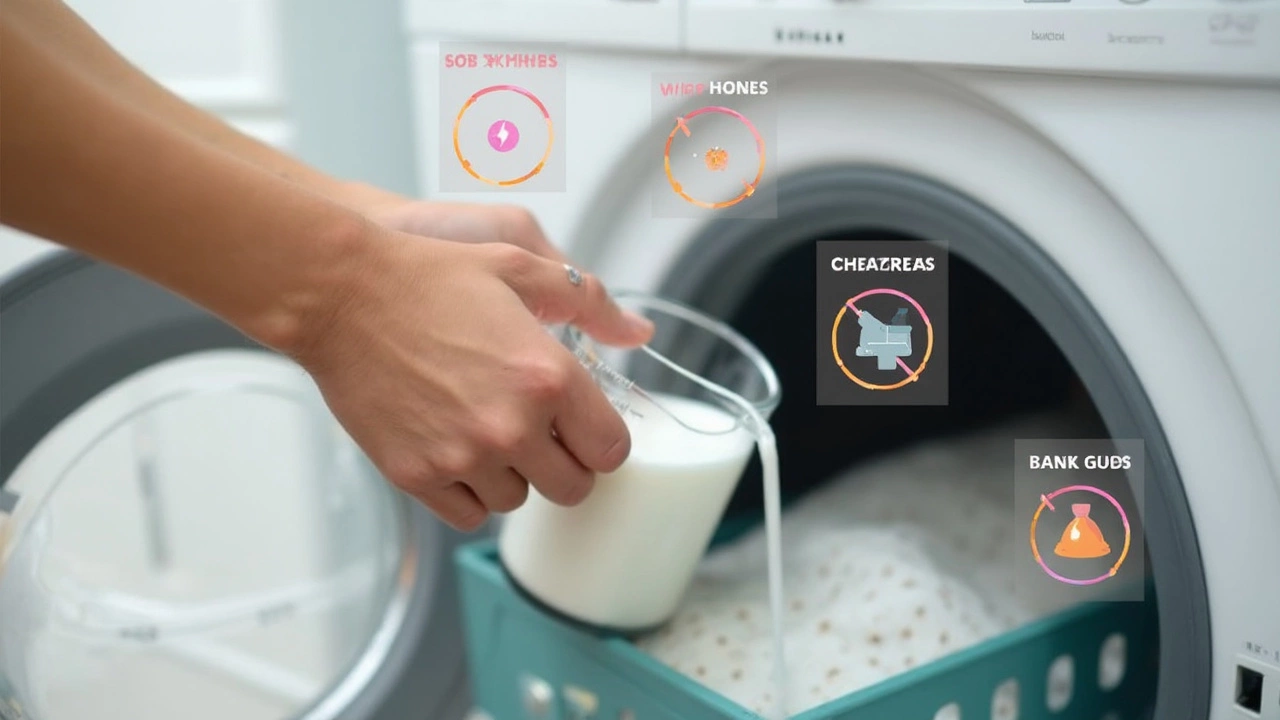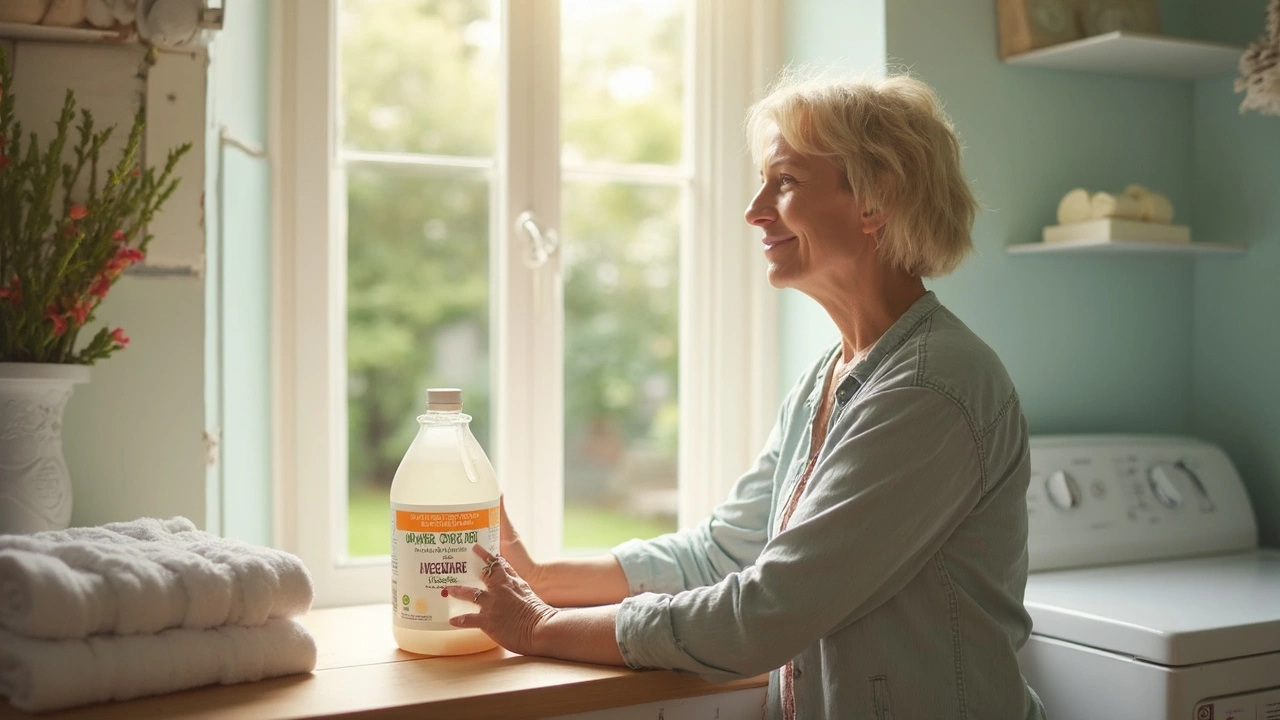Throwing a cup of white vinegar into the wash might sound weird, but thousands do it every day. The reason? Vinegar is cheap, easy to find, and doesn’t have the crazy chemical names you see on most cleaning products. Regular folks use it to knock out lingering smells in gym clothes, keep towels fluffy, and even fight off dullness in colors.
It’s not just some online rumor, either—white vinegar is acidic enough to break down the residues left by fabric softeners and some detergents. This helps clothes rinse cleaner, which means fewer itchy chemicals stuck to your shirts. If you’re chasing that fresh laundry smell without perfumes, vinegar gets high marks because it actually zaps odor-causing bacteria instead of just covering them up.
- Why People Reach for White Vinegar
- What Actually Happens in the Wash
- Tips for Using Vinegar in Laundry
- When Not to Use Vinegar
Why People Reach for White Vinegar
White vinegar is that bottle in your kitchen cabinet that somehow solves cleaning problems nobody asked for. People have been using it in laundry for decades because it just works, and it's dirt cheap. Most laundry detergents leave behind residue that makes dark clothes look faded or makes towels feel a bit stiff. A splash of vinegar can help rinse all that out, making your clothes softer and towels fluffier—without perfumes or harsh stuff.
One big reason people use white vinegar in laundry is for odor removal. It doesn't just hide smells; vinegar neutralizes and kills off the bacteria that cause all those funky scents. Cleaning experts point to acetic acid (what makes vinegar sharp) as the secret—it's strong enough to break up grime, but gentle enough that it won’t ruin most fabrics. Hospitals have even used diluted vinegar as a disinfectant, so tossing it into laundry isn’t far-fetched.
Fans also rave about vinegar’s ability to soften hard water. Minerals in hard water can mess with detergents and leave chalky buildup on clothes. Vinegar binds to these minerals, helping your laundry detergent actually do its job. Plus, eco-friendly folks like it because it keeps harsh chemicals out of the water system and your skin.
Check out how vinegar squares up against typical laundry solutions:
| Solution | Softens Fabric | Removes Odors | Kills Residue | Eco-friendly |
|---|---|---|---|---|
| White Vinegar | Yes | Yes | Yes | Yes |
| Commercial Softener | Yes | No (often perfumes only) | No | No |
| Basic Detergent | No | Sometimes | No | No |
If you’re allergic to strong scents or sensitive to chemicals, swapping in vinegar for the usual softeners can be a game changer. It’s easy to find, works fast, and you probably already have a bottle of it hanging around. That’s why more and more people are reaching for white vinegar when laundry day rolls around.
What Actually Happens in the Wash
When you add white vinegar to your laundry, a surprising chain of reactions takes place inside your washing machine. The acetic acid in vinegar isn’t strong enough to wreck fabrics, but it’s just right for breaking down mineral buildup and leftover detergent that sticks to your clothes and machine parts.
Vinegar acts a bit like a reset button—stripping away calcium, soap scum, and even hard water marks. That leaves clothes softer and less scratchy, and can even make colors stand out again instead of looking washed out. This is especially helpful if you notice your black t-shirts turning gray or your towels feeling stiff.
Odors are another huge reason people swear by this hack. Vinegar’s acidity kills some types of bacteria and fungi, which means gym socks and funky towels come out smelling way cleaner. It also helps get rid of smoke, sweat, or pet smells stuck deep in fabrics. If you ever catch a whiff of a “musty” scent from stuff that's been wet for too long, vinegar can often solve this.
Check out how vinegar changes your wash in the table:
| Benefit | How Vinegar Helps |
|---|---|
| Removes Odors | Kills some bacteria and neutralizes strong smells |
| Softens Fabrics | Breaks down residues that make clothes stiff |
| Brightens Colors | Gets rid of dulling film on clothes |
| Prevents Residue | Cuts leftover detergent and hard water spots |
Using white vinegar in your wash also helps keep your washing machine cleaner. You’re less likely to see mold or that weird gunk ring inside the drum or detergent tray. Most people use about half a cup to one cup, right in the fabric softener compartment, so it gets released during the rinse. No weird aftersmell—clothes come out clean and fresh, not like a salad.

Tips for Using Vinegar in Laundry
If you want to start using vinegar in your wash, don’t just pour it in and hope for the best. There are some handy ways to get results, and a few things to watch out for. Check out these practical tips:
- White vinegar is the only kind you want in your laundry. Skip apple cider or balsamic—they can stain fabrics and leave behind more weird smells than they fix.
- If your main goal is odor control, add half a cup of white vinegar to the rinse cycle, not in with your regular detergent. This gives it time to break down leftover soap and neutralize funky smells, especially in gym gear and kitchen towels.
- Tired of scratchy towels? Skip the regular fabric softener (which can build up over time) and pour half a cup of vinegar in the softener dispenser. It helps soften fibers without any greasy residue.
- Worried about bright colors fading? A splash of vinegar in the rinse can actually lock in color and keep darks looking less faded.
- For pillowcases and sheets, vinegar does a solid job breaking up body oils and sweat that detergents barely touch. Just don’t overdo it—a half cup is plenty for a standard load.
If you have a front-loading washer, use the designated fabric softener compartment for vinegar. For top-loaders, pour it in during the rinse cycle. Never mix vinegar right in with bleach—it can create dangerous fumes.
And don’t worry, your clothes won’t come out smelling like a salad. The scent usually disappears completely once the load dries.
When Not to Use Vinegar
Vinegar can mess up some laundry loads if you're not careful. For starters, steer clear of using it with bleach—combining vinegar and bleach creates toxic chlorine gas, and that's nothing you want to breathe in at your laundry room. Even a small amount can irritate your lungs and eyes.
Delicate fabrics and certain finishes have trouble with vinegar too. If you've spent extra money on specialty gym gear, silk, or rayon, keep the vinegar away. The acid can break down those materials faster, leaving them weaker or even fading the color. Some water-repellent or fire-resistant finishes on outdoor clothing can wear off quicker when washed with vinegar.
Front-loading HE washers have sensors and rubbers seals that don't play nice with vinegar over time, either. Regular vinegar cycles might cause those gaskets to wear out faster, and the sensors can get a thin residue buildup that messes with the machine's performance down the road.
Check the table below to see a quick guide on fabrics and situations where you should skip the vinegar:
| Item/Fabric | Why to Avoid Vinegar |
|---|---|
| Bleach Use | Toxic gas reaction |
| Silk, Rayon, Acetate | Fiber damage and color fading |
| Sports Gear (w/ special coatings) | Breaks down water-repellent finishes |
| HE Washer Rubber Seals | Speeds up rubber breakdown |
| Flame-Resistant Pajamas | Removes fire-retardant treatment |
If you’re washing any of these or not sure what’s in your load, skip the white vinegar and just run a regular cycle.
